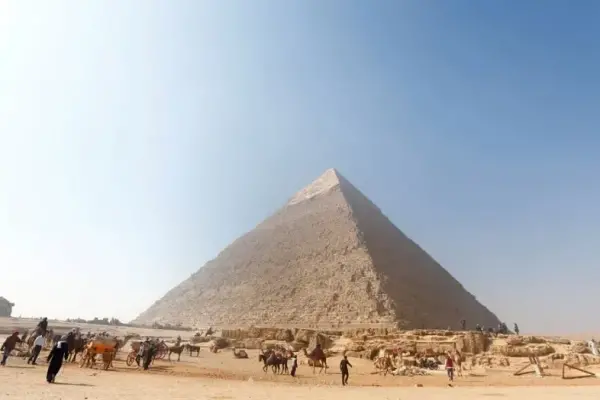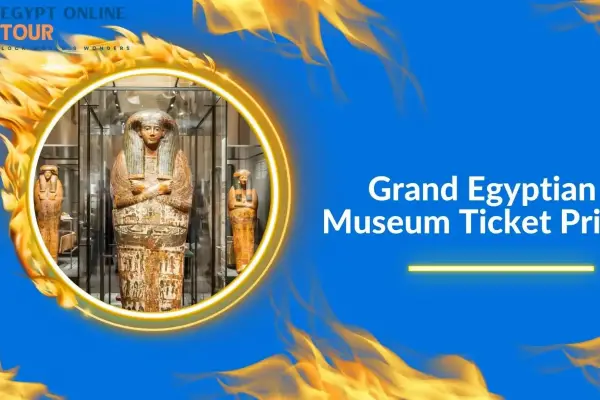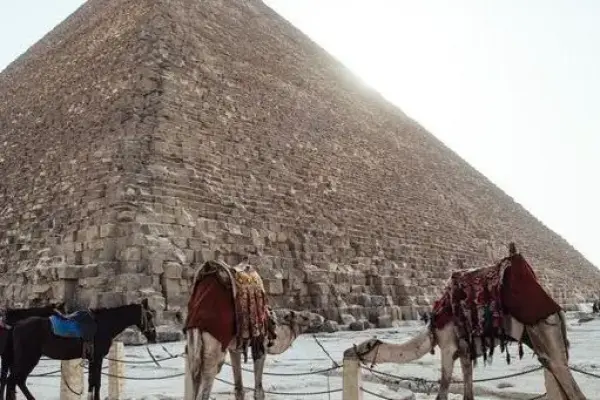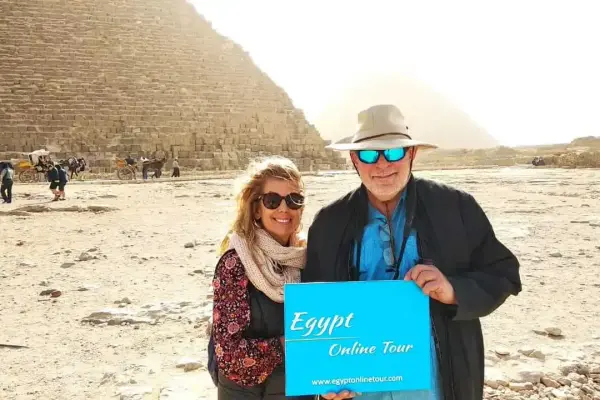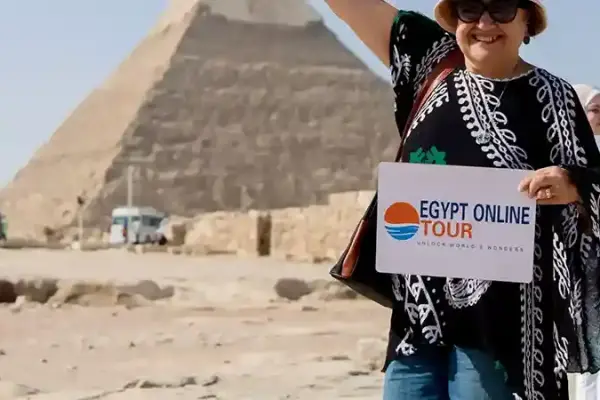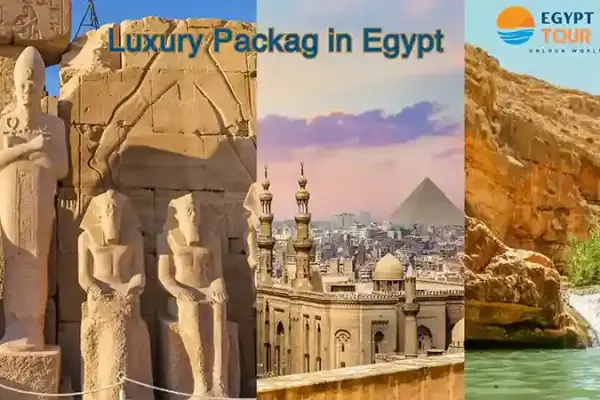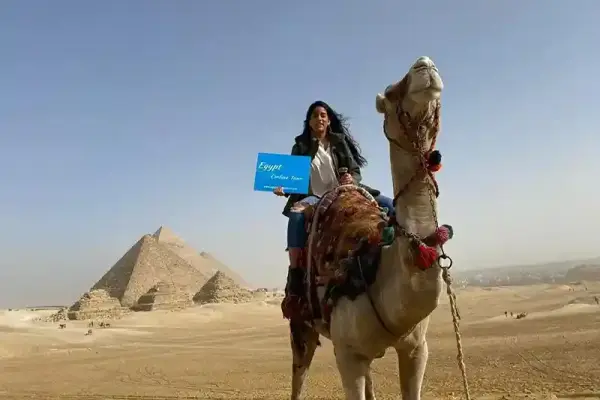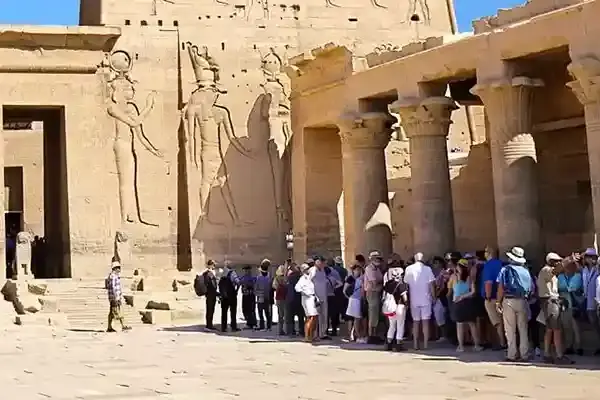Let's reveal the secret: What is in the Sphinx of Egypt
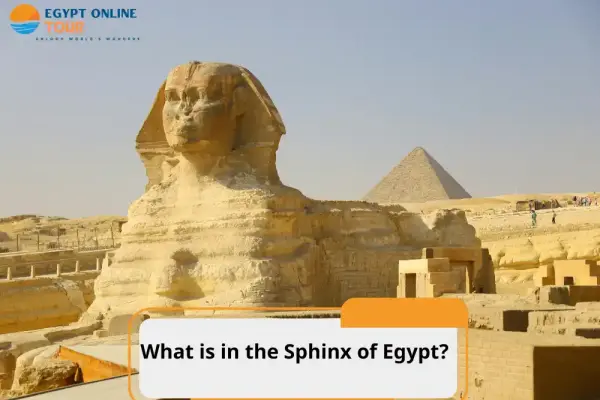
- Feb 20, 2025
- Ancient Egyptian Civilization
- 2,622
The Sphinx statue of Giza is one of the most famous and mysterious monuments in the world. This ancient statue has stood on the Giza Plateau for thousands of years, inspiring countless myths, debates, and research. In this article, we will reveal what is in the Sphinx of Egypt and the wonderful aspects of the sphinx, helping to understand its importance and the secrets that surround it.
Table of contents [Show]
-
The history and facts about the Great Sphinx of Giza
- History:
-
Facts:
- 1. Origin and age of the Sphinx
- 2. Sphinx as a symbol of power
- 3. Lost Nasal Mystery
- 4. Sphinx and temples
- 5. The Changing Colors of the Sphinx Father
- 6. Geological studies and corrosion discussions
- 7. Aligning the Sphinx
- 8. Secret of buried rooms
- 9. Conservation and restoration efforts
- 10. The Great Sphinx of Popular Culture
- Where is the Egyptian Sphinx located? How close is it to the Giza Pyramids?
- What is the original Sphinx of Giza made of?
- How did the Sphinx lose its nose?
- What is in the Sphinx of Egypt?
- Why visit The Great Sphinx of Giza?
- Which activities are available at the Great Sphinx?
- What is the best time to visit the Egyptian Plateau?
- What is the easiest way to get to the Great Sphinx of Giza?
- What is the cost to visit the Great Sphinx of Giza?
- Types of travelers who will enjoy visiting the Great Sphinx of Giza?
- Safety tips for visiting the Great Sphinx of Giza?
- Conclusion
- FAQs
The history and facts about the Great Sphinx of Giza
An iconic representation of ancient Egypt, the Great Sphinx of Giza is a massive limestone statue that shows a legendary monster with a human head and a lion's body. At 73 meters (240 feet) in length, 19 meters (62 feet) in width, and 20 meters (66 feet) in height, it is the biggest monolith statue in the world.
History:
The Sphinx is thought to have been constructed by the ancient Egyptians during the rule of Pharaoh Khafre of the Old Kingdom. It is situated on the Giza Plateau, next to the Great Pyramids of Giza.
The purpose of the Sphinx is still up for debate among academics. Some speculate that it might have had a religious or astronomical purpose, while others think it was constructed as a guardian for the Giza Necropolis. The Sphinx Temple, which is close to the statue's paws, gives the location even more mystery.
Read about: Did Thoth Built The Pyramids
Facts:
The Sphinx still evokes amazement and surprise in everyone who sees it.
1. Origin and age of the Sphinx
Research on the Sphinx has been extensive, but conclusive evidence about his age and origin remains elusive. Some scientists suggest it could be older than currently thought, possibly dating back to pre-family civilization. The controversy surrounding the age of the Sphinx highlights the complexity and ambiguity surrounding ancient Egyptian history.
Archaeologists and Egyptologists believe it was carved from limestone around 2500 BC under Pharaoh Khafra, also responsible for building the second-largest pyramid in Giza. The Sphinx is believed to be over 4,500 years old, making it one of the world's ancient wonders.
2. Sphinx as a symbol of power
The Great Sphinx is believed to represent power and royal power. With the body of a lion and the head of a human being, it is generally believed to be the body of the pharaoh Khafra; it symbolizes a combination of human intelligence and the brute force of the lion.
3. Lost Nasal Mystery
One of the most instantly recognizable features of the Sphinx is the missing nose. There are many theories about what happened to it.
4. Sphinx and temples
Next to the Sphinx are two ancient temples that form part of its compound: the Sphinx Temple and the Valley Temple. Both were built similarly, featuring huge blocks of limestone, and are thought to have been used for religious purposes. The temples further emphasize the importance of the Sphinx statue in ancient Egyptian rituals and culture. These temples likely played a crucial role in the funeral rites of pharaohs and may have been the sites of other celebrations of the rulers.
5. The Changing Colors of the Sphinx Father
The changing colors of the Sphinx throughout the day and across seasons also have a charming effect. As the sun moves across the sky, the manipulation of light and shadow across the statue constantly alters the Sphinx's appearance, increasing its charm and lasting mystery.
6. Geological studies and corrosion discussions
Geologists studied the Sphinx statue extensively, leading to numerous discussions about the erosion patterns observed on the statue's body. Some researchers claim that erosion is mostly caused by wind and sand, which corresponds to their age, as Egyptologists have suggested.
7. Aligning the Sphinx
The Sphinx lined with the pyramids of Giza creates a harmonious connection between these archaeological structures and celestial movements, reflecting the knowledge and skill of ancient Egyptian astronomers and architects. They undoubtedly understood the importance of celestial bodies and their movements and incorporated that into their vast work.
8. Secret of buried rooms
There has long been speculation about the possibility of hidden rooms buried under the Sphinx statue.
9. Conservation and restoration efforts
Egypt's Supreme Council for Antiquities oversees the preservation of the Sphinx statue, ensuring that repair works respect original materials and methods as much as possible. The goal of these restoration efforts is to install the Sphinx statue and mitigate the risk of erosion and pollution, helping to preserve this important symbol of Egyptian heritage for future generations.
10. The Great Sphinx of Popular Culture
Sphinx plays an important role in popular culture, appearing in many films, books, and artworks as a symbol of mystery and ancient wisdom. From his pivotal role in "The Mummy" to his representation in literary works such as Oedipus Rex, the Sphinx is a well-known cultural symbol worldwide.
This cultural representation contributes to the constant fascination with the Sphinx and ancient Egypt in general, often raising people's interest in visiting Egypt and experiencing this historical marvel directly. You will also be wondering about Strange Facts About The Pyramids .
Where is the Egyptian Sphinx located? How close is it to the Giza Pyramids?
Located in the Egyptian city of Giza, the Sphinx is one of the most famous historical monuments in Egypt, due to its unique appearance and distinctive location near the pyramids of Giza, one of the most important symbols of ancient Egyptian civilization alongside this historic statue. Egypt is considered the top destination mostly due to pyramids land private tours .
What is the history of the architecture of the Great Sphinx?
Many historical and archaeological scholars point out that this great statue dates back to ancient Egyptian civilization, specifically to the period of rule of the Fourth Dynasty that ruled Egypt at the time, and evidence suggests that the statue was carved under King Khafra (circa 2525-2532 BC). M.L.)
It is the oldest known huge sculpture, about 73.5 meters long, including 15 meters the length of its front legs, and 19.3 meters wide, and its highest height from the Earth's surface is about 20 meters to the top of the head. The Sphinx statue was built in the face of sunrise, where it was completely carved from the limestone of a mysterious creature with the common qualities of a lion and man. Don’t miss the opportunity of 8 Days Pyramids & The Nile by Air to enjoy the inspired view.
What did the Sphinx originally look like?
With a lion's body sitting in front of a sundeck and carving his head in the shape of a royal human being. The lion embodies the symbol of strength and toughness, and the man's head symbolizes wisdom. The Sphinx has captured the imagination of travelers and explorers for thousands of years. Even in ancient Egyptian times, during the eighteenth dynasty (1550–1295 s. M.L.), it was seen as a manifestation of the Sun God, and Hor M. Achet was called "Horus on the horizon," and King Amenhotep II was built (about 1427–1400 BC). M.L.) A temple next to the Sphinx statue was dedicated to this God, as was his son Thutmose IV.
Read more: Is The Sphinx Older Than The Pyramids
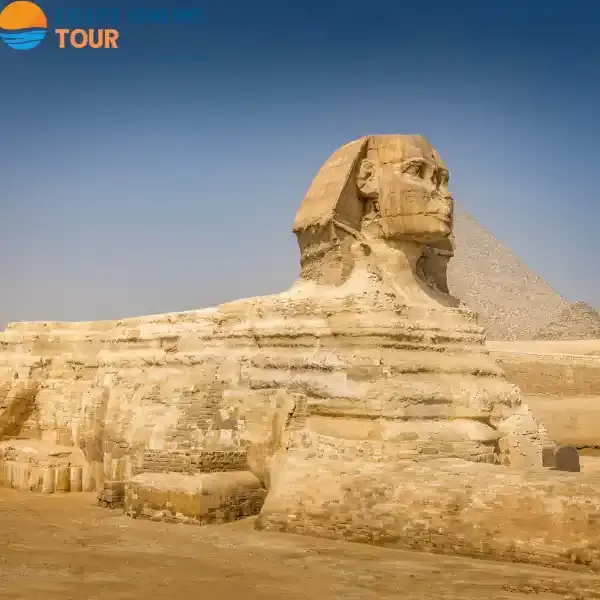
What is the original Sphinx of Giza made of?
For decades, experts agreed that the detailed face of the famous limestone statue was likely manually etched by stone construction workers, but they never worked out how to create the massive, layered body.
According to a recent study, the 4,500-year-old Sphinx monument at Giza, which stands in front of the pyramid of Khafre, may not have been entirely constructed from the ground up but rather was based on a naturally occurring feature that already had an incredibly sphinx-like appearance.
According to a team from New York University, a yardang—a wind-blown ridge of rock protruding from the ground—can naturally evolve into a sphinx-like structure. Their findings were published in the journal Physical Review Fluids.
The researchers noted that even if the Sphinx had been fashioned from a spooky-shaped block of rock, the ancient Egyptians would still have needed to carefully craft its recognizable traits, which are still in place today.
How did the Sphinx lose its nose?
The loss of the Sphinx nose has been the subject of legends for hundreds of years. The story of Napoleon's soldiers firing a cannonball that struck the nose and broke it off is one that many of us have heard. Long before Napoleon's reign, in 1737, Dane Frederic Louis Norden drew sketches of the Sphinx, which were published in 1755. These illustrations, however, show the Sphinx without a snout, which is obviously at odds with the tale. What actually occurred, then?
According to the 15th-century Egyptian Arab historian al-Maqrīzī, a Sufi Muslim named Muhammad Sa'im al-Dahr actually smashed the nose. Offerings were made to the Great Sphinx by Egyptian peasants in 1378 CE in the hopes of regulating the flood cycle and ensuring a bountiful harvest. Sa'im al-Dahr was executed for vandalism after destroying the nose in outrage at this obvious display of devotion. It is still up for debate whether this is an unchangeable fact.
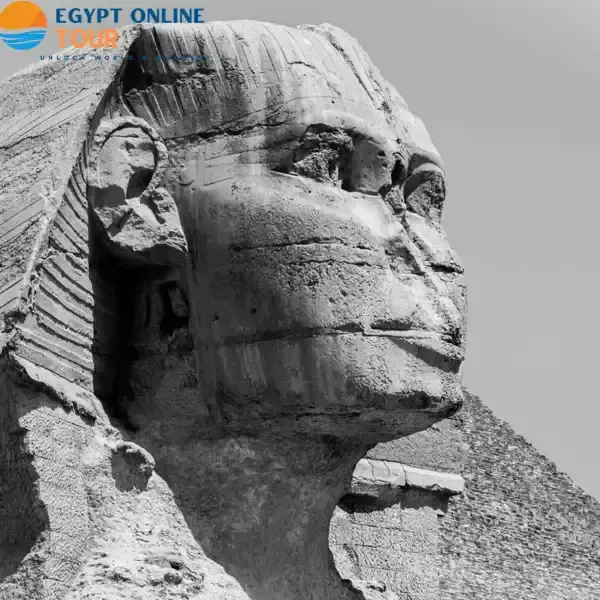
What is in the Sphinx of Egypt?
The building is the subject of numerous tales and legends that have gained popularity over the ages. For instance, some people think that the Sphinx was first built by aliens or that it contains a secret passageway or buried wealth. Even though there is no proof to back up these tales, they contribute to the monument's allure and mystique.
Over the years, numerous attempts to investigate the Sphinx's interior have failed mostly because of the difficulties presented by the building's design and state.
Examples of attempts to investigate the Sphinx's interior
- Giovanni Caviglia, an Italian explorer, tried to discover the Sphinx's entrance in 1817 but was only able to locate a blocked passage that led to a sealed chamber. Later, in 1925, an archaeologist from Britain, Cecil Firth, found that ran into the center of the Sphinx, which has since been shut off and filled in for security.
- Mark Lehner, an Egyptian archaeologist, led a team in 1993 that used the most recent ground-penetrating radar equipment available to explore the Sphinx. Deep beneath the Sphinx, they found a number of chambers, one of which might have formerly contained the mother of Pharaoh Khufu's buried remains. But since then, there have been no more digs or expeditions inside the Sphinx.
You can perform your attempt not to discover the Sphinx's interior but to explore this great civilization through Egypt Luxury Tours .
Why visit The Great Sphinx of Giza?
The chance to encounter a piece of history is the primary reason to visit the Great Sphinx. Around 2500 BC, during the time of Pharaoh Khafre, the Great Sphinx was constructed; it is evidence of the engineering skill and civilization of ancient Egypt. It offers a glimpse into the way of life in ancient Egypt and has endured for so many generations.
Second, the Great Sphinx offers a chance to be in awe of its immensity and magnificence. Blocks of limestone, each weighing up to 2.5 tons, are used to make it. It is very amazing to see this enormous edifice up close!
Third, tourists have the opportunity to delve into the mysteries of the Great Sphinx. There are still a lot of issues regarding this monument, like is The Sphinx Older Than The Pyramids and who constructed it. Finally, viewing the Great Sphinx can be a spiritual experience as well.
Read about: Can You Go Inside The Great Pyramids
Which activities are available at the Great Sphinx?
To complete your experience in the Pyramids region, there are many activities you can do to live dazzling moments amid this historic landmark. In this report, we review the highlights of events that make your visit to this region an unforgettable experience.
Commemorative Photo Capture
Most of the things many prefer during a hike or space with parents or friends are authentication by taking photographs. This is helped by the presence of mobile phones with cameras, which made the opportunity to take a special photo very easy; you just need to guide yourself in front of the pyramids or sphinx and take a beautiful picture from in front of it. 10 Days Round Trip Nile Cruise and Pyramids will satisfy your experience if taking photos is your preferred hobby.
Riding camels and horses
Riding at the pyramids, it is best to head to the village stables (next to the Sphinx parking lot), where guides are recommended and horses are kept in good condition. The best time to go horseback riding or camel riding in the pyramid area is at sunset, where you can head to the surrounding desert for archaeological views with sunset.
Display sound and light
The display of sound and light in the pyramids of Giza allows you to see these ancient monuments lit up under the night sky with narrative soundtracks presented by the Sphinx. It will be very fun to enjoy the history of ancient Egyptian civilization with a pleasant dinner with friends or family.
Visit to the Grand Egyptian Museum
The Grand Egyptian Museum is located on the Giza Plateau, in front of the Pyramids area, about 2.5 km northwest of the main entrance to the Pyramids Complex. Through your Grand Egyptian Museum Tour , you will see the entire collection of the Tutankhamun funeral treasure is permanently displayed for the first time since the discovery of its tomb in 1922, as well as many other non-exhibited artifacts and pharenics.
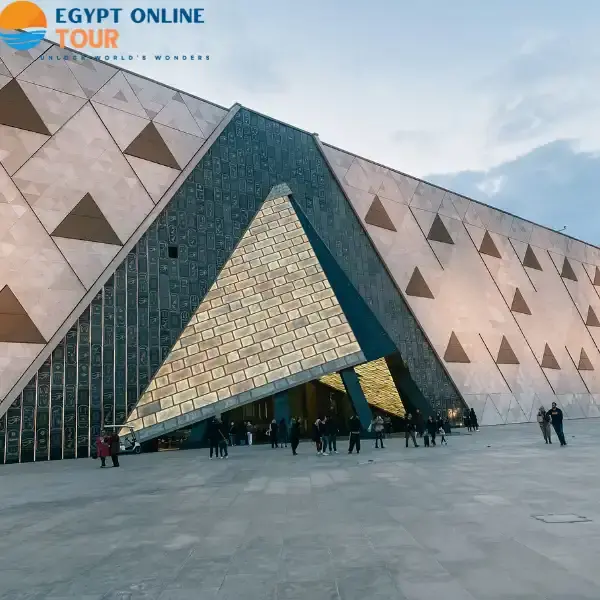
What is the best time to visit the Egyptian Plateau?
It is possible to visit the Egyptian Plateau at any time of the year, but the peak season is from November to February. Egypt Temperatures in December to February are the ideal weather for the winter season of tourism in Egypt.
Peak season (November to February):
With milder weather and easier access to the archaeological site, these are the ideal months to schedule a trip to the Giza Necropolis. You will have less time to explore the complex, though, as the Pyramids close early in the winter.
The mid-season (March to May and September to October):
The weather starts to warm up during the mid-season. To enter the Necropolis before the sun rises, arrive early in the day.
Low season (June to August):
Egypt's scorching temperatures make outdoor activities intolerable during this time of year.
Opening times and days open of the Giza Plateau
For working hours, the Pyramids of Giza receive visitors daily from 7 am to 5 pm Cairo Time, preferably once the pyramids are opened, to avoid crowding and enjoy about two or three hours of calm before the arrival of tourist groups.
If you are setting up an hourly program, we advise you to set aside 4 to 5 hours to explore the pyramids leisurely, and you may need longer if your visit to all the region's shrines expands. Book your Egypt tour packages now.
Weekend vs. Weekday
Hundreds of people visit the Pyramids on weekends and public holidays. To get inside the Necropolis before the morning rush, which starts at around 10 am, try to arrive early in the day. To cut down on wait times, purchase skip-the-line tickets.
Compared to weekends, there are fewer tourists during the week. You can enter the Giza Necropolis complex in 30 minutes, although there are still lineups to wait. Try scheduling your visit for a weekday when the grounds are relatively quieter if you want to explore the Great Pyramid's inner burial chambers, go on a camel safari, and take in the Light and Sound Show to the fullest.
Discover the Cheapest Time to Go to Egypt .
What is the easiest way to get to the Great Sphinx of Giza?
If your trip is within a group, the majority of hotels and tourist companies offer pyramid tours that include delivery to and from the hotel. If you prefer to visit individually or independently, "Uber" is the easiest way to reach the pyramids. The distance from Cairo International Airport to the pyramids can be estimated at 60 minutes by car.
Flights to Sphinx Airport, near the Pyramids Plateau, also facilitated access, with only a few minutes. Cairo has an extensive range of transportation options, making it simple to travel from Cairo to the Giza Pyramids.
Options include taxi (convenient), bus (crowded), metro (economical, but no nearby station), walking (if close enough), and organized tour (recommended for ease and efficiency). If you want to know more about how far are the pyramids from Cairo and how to get there, just click this link for a complete guide.
What is the cost to visit the Great Sphinx of Giza?
Pyramid Area ticket prices for foreign tourists are up to LE360 for foreign tourists instead of LE240, and for foreign students at LE180. (USD is equal to EGP 30.9).
The prices for tickets to the inland pyramid of Chef for foreign tourists are 600 pounds and for foreign students are 300 pounds, while the price of a ticket for a sunken pyramid is 150 pounds for foreign tourists and 75 pounds for foreign students, and the price of a ticket for workers' cemeteries is 500 pounds.
The ticket price to visit the Sphinx and the site's opening fee for foreign tourists is 150 pounds. If you wish to enjoy the sound and light display, you can book and choose from different dates.
You can also find out How Much Does It Cost to Go to Egypt and know the most about your journey.
Types of travelers who will enjoy visiting the Great Sphinx of Giza?
A wide variety of tourists are drawn to the Great Sphinx of Giza because of its worldwide appeal. The Sphinx's ancient beginnings and its association with the Old Kingdom pharaohs will captivate history buffs. Culture vultures will appreciate the statue's significance in Egyptian mythology and its symbolic meaning.
The Sphinx is an enticing subject for photographers because of its intimidating size and distinctive features, which offer countless chances to take breathtaking pictures. Exploring the nearby Giza Plateau, finding secret tombs, and learning about ancient Egypt's mysteries will be enjoyable for adventurers.
The Sphinx is a wonderful place for families with kids as well. Young brains are sure to be captivated by the statue's immense size. Children can learn about ancient civilizations and the wonders of the ancient world on the Giza Plateau, which provides a unique educational experience.
Consider Egypt Classic Tours for a majestic experience.
Safety tips for visiting the Great Sphinx of Giza?
Prioritizing your comfort and safety while honoring the site's cultural value is crucial when visiting the Great Sphinx of Giza.
Due to the nature of the sandy and rocky area, where limestone, it is best to wear sneakers comfortable for walking.
Since the Giza Plateau is an outdoor location, wear weather-appropriate clothing. It is preferable to wear light clothing and cotton trousers to facilitate movement, especially if you ride horses or camels.
It is also recommended that you do not forget your hat and sunglasses to protect yourself from sunlight. For women, the light scarf is suitable to protect them from the heat and sandstorms that might happen.
Keep enough water on hand to remain hydrated. Additionally, since there are not many food alternatives on-site, it is a good idea to pack light meals or snacks.
Although travelers are normally safe on the Giza Plateau, exercise caution and pay attention to your surroundings to safeguard your possessions. Keep a careful watch on your possessions at all times and refrain from carrying huge sums of money or jewels to avoid losing them in sands. Explore: Is it Safe to Visit Pyramids of Giza ?
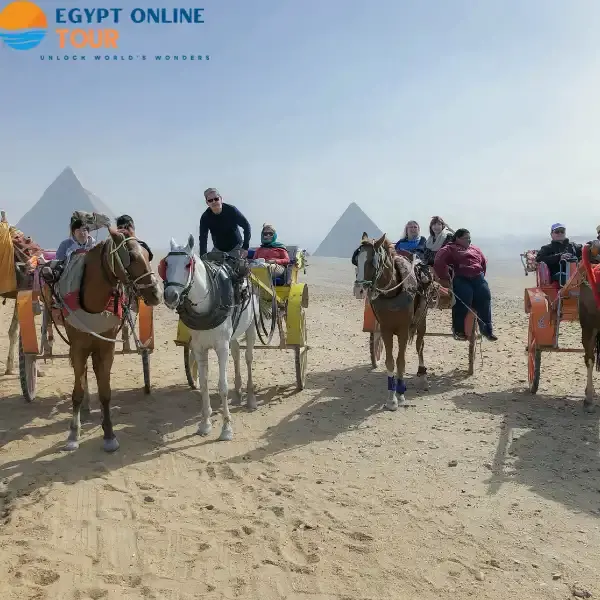
Conclusion
We began this article with the question, what is in the Sphinx of Egypt, and we didn't expect to have this valuable information and interesting facts about the Sphinx.
We can now complete the foregoing by saying that the Sphinx promises an amazing experience that will leave you with enduring memories and greater respect for the rich history and culture of Egypt, whether you are traveling alone, with a partner, with family, or with friends. Prepare your tour now and contact Egypt Online Tour.
FAQs
What is older the pyramids or the Sphinx?
Because the hydrological characteristics of the area were significantly changed by the quarries, he contends this suggests that the sphinx likely predated the quarries (and thus, the pyramids).
Is there anything inside the Sphinx?
American clairvoyant Edgar Cayce, who died in 1945, famously claimed that an ancient library was hidden below the statue. This so-called Hall of Records documented Earth's ancient past, but there is no evidence for its existence, and the claim is widely discredited.
What was found under the Sphinx in Egypt?
They found several rectangular chambers roughly 20 feet beneath the sphinx's paws. The cavern beneath the Sphinx had not been verified, but the theory did give the notion some legitimacy. The most well-known myth involving the Sphinx is, of course, the Hall of Records.
Popular Categories
Popular Posts

Top Alexandria Beaches You Must Visit 2026

What are the important holidays in Egypt?
